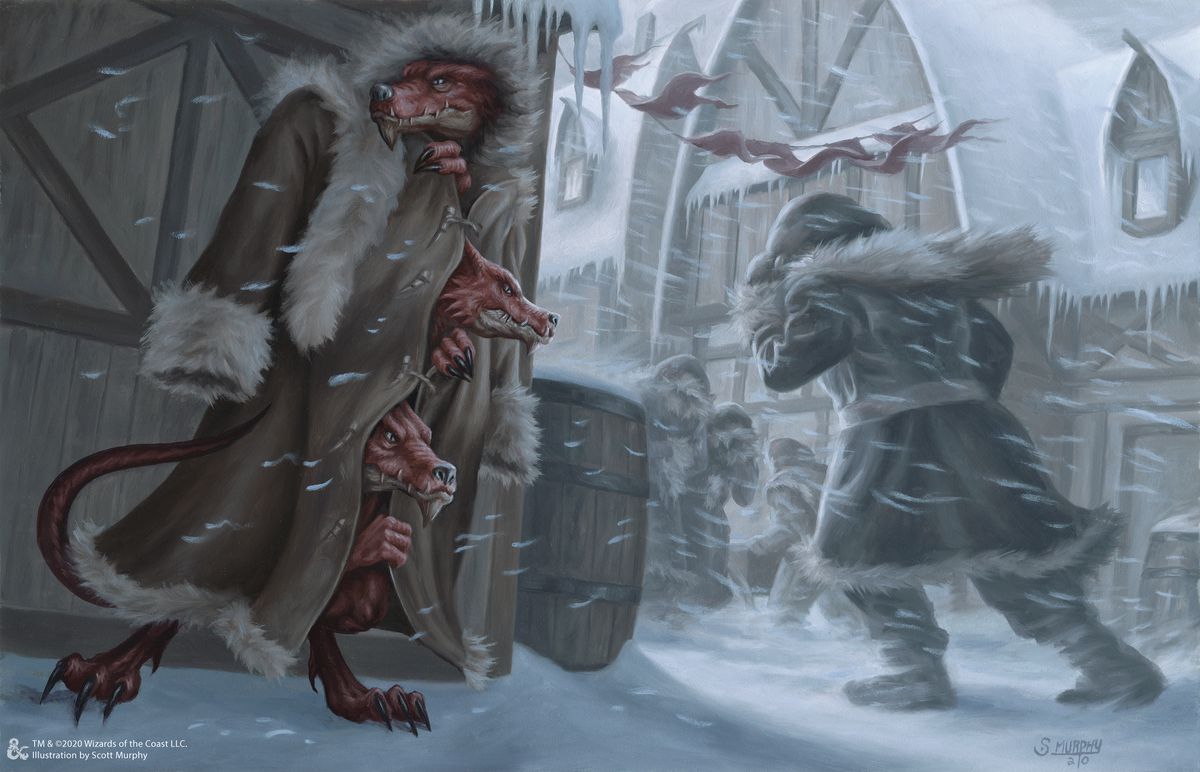Van Richten’s Guide to Ravenloft, the newest book for Dungeons & Dragons, has a shocking omission. While it details nearly 40 different horror-themed settings, each with their own powerful villains, none of those villains are given a stat block — a chunk of numbers and text detailing how they fight and how many hit points they have. That doesn’t mean you can’t fight them, but it does mean that developers at Wizards of the Coast are encouraging you to go about things differently this time around. It’s a welcome change in my opinion, and one that enriches the game overall.
For context, let’s roll back the clock here to 2008 and the launch of the 4th edition of D&D. That version of the classic role-playing game very heavily emphasized combat, something that my gaming group really enjoyed. We spent hours fixing enemies in place and flanking them, and we had all sorts of player aids — mostly magnetic tokens from Alea Tools — to remind us of who was bloodied, who was marked, and who had most recently been the victim of a potent Eldritch Blast. Much of my prep time as a Dungeon Master was spent figuring out fun tactics for baddies to employ, and wild terrain for us all to fight over.

Mostly we played on Gaming Paper, thin sheets with one-inch grids that we would mark up and throw out at the end of every session. But I tried some fun stunts everyone once in a while. Once I made a vertical encounter using a cork board, push pins, and packing foam. Another time I adjusted the terrain on the fly using an unopened pack of Magic: The Gathering cards, drafting new sections of the map to fight over as we went along. But all that combat ultimately slowed our game down. We would get together once or twice a month, and our four-hour session would invariably hinge on a single, spectacular battle. That didn’t leave a lot of room for other kinds of role-playing, and even when it did, everyone at the table knew that eventually we’d need to draw swords again to move the story along.
Yes, there were rules and guidance for other kinds of encounters in 4th edition. Published adventures were full of them, in fact. But the guidance given to players — and the powerful increases they were promised with each level gain — were all strongly weighted toward combat. That made the experience very one-note.
In the modern 5th edition of D&D, things are more balanced. In fact, the game launched with a clear indication that theater-of-the-mind-style play — one that avoids using miniatures or tokens of any sort — was baked right into the core books. Published adventures followed that trend. Playing through Waterdeep: Dragon Heist we found plenty of ways to advance our standing with various in-game factions. Later, knee deep in Curse of Strahd with my gaming group, I was impressed by the breadth of non-combat role-playing situations Wizards offered to players.
It all culminated for me with Icewind Dale: Rime of the Frostmaiden. For the first few sessions, our group spent quality time hanging out in a fearsome, interesting location. We met the locals, talked up a sea monster, and met a curious traveling marketplace. It was a highly narrative, extremely engaging experience.

After the fourth session, I realized we had been sitting at the table for the better part of 10 hours without once rolling a die in anger.
It was with that experience in mind that I sat down to review Van Richten’s Guide to Ravenloft. What I found was an entire chapter, titled “Creating Domains of Dread,” dedicated to the creative process, to inspiring DMs to weave a story in between the players at their table and the themes inside that book. There were fully-formed villains, to be sure; later chapters contain some of the most powerful that the game has ever seen. But, thanks to this one chapter, I wasn’t worried about how many hit points they had or which particular damage types they were immune to.
Instead, Van Richten’s Guide made me curious about my potential villain’s motivations, their needs, their wants, and their desires. I read through the rest of the book to know who these named villains were in order to better understand why my players might want to fight against them or — gods forbid — join them. The book helped me to get excited about narrative conflict instead of physical conflict.
Van Richten’s Guide to Ravenloft is bursting with new kinds of role-playing content for players to explore. Players and DMs who are upset that there are no stat blocks for villains, who feel slighted by what they see as an oversight, are missing the point. The book is trying to encourage your games to grow in a different direction, and to do that, its authors have chosen to omit the kinds of content that, like the force of gravity, pulls groups inexorably towards violence.
Maybe try it their way this time … or just go make a stat block for your favorite villain. If it’s not quite right, then tweak it on the fly to keep things balanced at the table. As a DM, you’re in control of your own game, and you get to roll the dice behind a screen when you need to. Have the kind of fun that you want with your gaming group, but let Van Richten’s Guide to Ravenloft be what it is — a book about storytelling, not about stat blocks.
Polygon – All
Source link
Related Post:
- Lost Judgment Receives New Gameplay of School Setting, Skateboarding and More
- New Life Is Strange: True Colors Trailer Shows Off Colorado Setting, Arcade Machines
- New Marvel Future Revolution Video Is All About Its Setting
- Dragonlance creators announce new setting based on the D&D 5e ruleset
- New Valorant agent KAY/O gameplay preview – Created to kill
- Watch a badass cinematic for the new Warhammer 40,000: Kill Team
- Games Workshop promises not to sell out of new Warhammer 40K Kill Team
- Reggie Fils-Aime has a book coming out next year – Disrupting the Game: From the Bronx to the Top of Nintendo
- REVIEW: Necromunda: Hired Gun’s setting is its only real strength
- EVE Online’s record-setting war ends with a whimper
